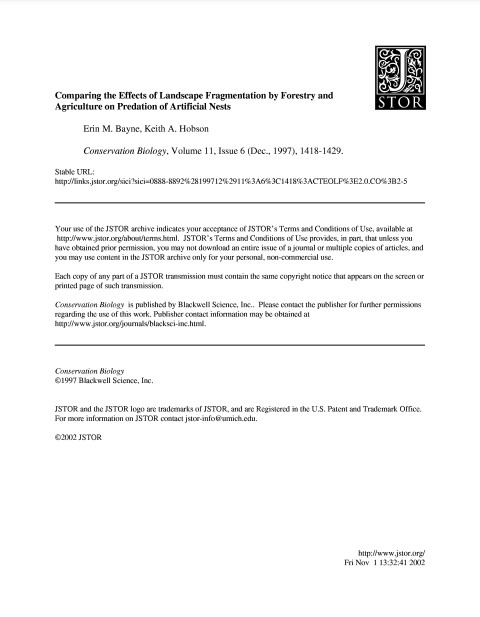Comparing the Effects of Landscape Fragmentation by Forestry and Agriculture on Predation of Artificial Nests
Bosque Modelo:
Prince Albert
Temática:
Gestión forestal
Tipo de documento:
Artículo científico
Resumen
Fragmentation of forested landscapes can reduce the reproductive success of birds occupying residual forest patches. Previous studies, however, have focused primarily on how nest predation can change when landscapes become fragmented by agriculture rather than by logging. To determine if predation on artificial nests in forest patches was influenced by the surrounding landscape, we placed ground and shrub nests along the edge and interior of forest patches located in agricultural, logged, and contiguous forest landscapes within a single region of the southern boreal mixedwood forest of central Canada. Nest predators were identified using remotely triggered cameras and by marks left in plasticine eggs, whereas the relative abundance of nest predators such as corvids and small mammals was estimated by surveys and live-trapping. The percentage of ground nests destroyed at the edge and interior of patches in the logged and contiguous forest landscapes was significantly lower than at the edge or interior of patches in the agricultural landscape. No differences in predation rate were observed for shrub nests among landscapes. We attributed higher rates of predation in the agricultural landscape to higher densities of red squirrels ( Tamiasciurus hudsonicus) in the interior and a greater diversity of predators along edges. The similarity in predation rate between logged and contiguous forest landscapes suggests that fragmentation caused by logging may result in little change in predator communities and in this respect, might be similar to fragmentation caused by natural disturbance regimes such as fire. In contrast, fragmentation by agriculture seems to have more serious consequences for nesting birds. Policy changes that limit the growth of agriculture in the southern boreal mixedwood forest are required to conserve the diverse avifauna of this region.
Información Bibliográfica
Autor:
Bayne, EM and KA Hobson.
Revista:
Conservation Biology
Año:
1997
N°:
6
País :
Canadá
Páginas:
1418 - 1429
Volumen:
11
Idioma:
Ingles
Palabras claves
Fragmentation, forest, mammals





